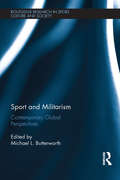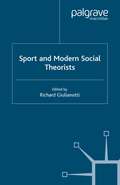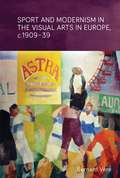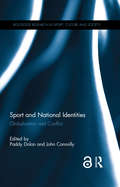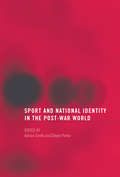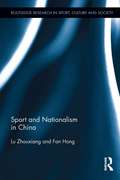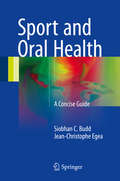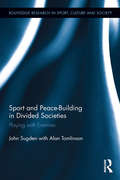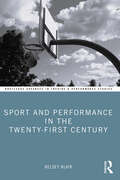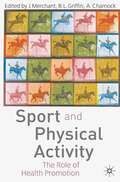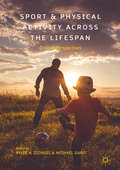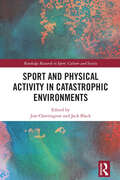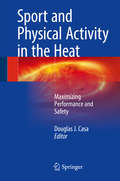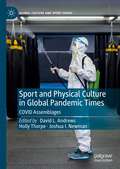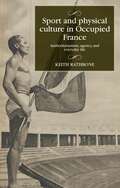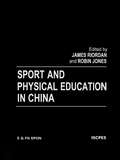- Table View
- List View
Sport and Militarism: Contemporary global perspectives (Routledge Research in Sport, Culture and Society)
by Michael L. ButterworthThe institutional relationship between sport and the military appears to be intensifying. In the US for example, which faced global criticism for its foreign policy during the "war on terror," militaristic images are commonplace at sporting events. The growing global phenomenon of conflating sport with war calls for closer analysis. This critical, interdisciplinary and international book seeks to identify intersections of sport and militarism as a means to interrogate, interrupt and intervene on behalf of democratic, peaceful politics. Viewing sport as a crucial site in which militarism is made visible and legitimate, the book explores the connections between sport, the military and the state, and their consequent impact on wider culture. Featuring case studies on sports such as association football, baseball and athletics from countries including the US, UK, Germany, Canada, South Africa, Brazil and Japan, each chapter sheds new light on the shifting significance of sport in our society. This book is fascinating reading for all those interested in sport and politics, the sociology of sport, communication studies, the ethics and philosophy of sport, or military sociology.
Sport and Militarism: Contemporary global perspectives (Routledge Research in Sport, Culture and Society)
by Michael L. ButterworthThe institutional relationship between sport and the military appears to be intensifying. In the US for example, which faced global criticism for its foreign policy during the "war on terror," militaristic images are commonplace at sporting events. The growing global phenomenon of conflating sport with war calls for closer analysis. This critical, interdisciplinary and international book seeks to identify intersections of sport and militarism as a means to interrogate, interrupt and intervene on behalf of democratic, peaceful politics. Viewing sport as a crucial site in which militarism is made visible and legitimate, the book explores the connections between sport, the military and the state, and their consequent impact on wider culture. Featuring case studies on sports such as association football, baseball and athletics from countries including the US, UK, Germany, Canada, South Africa, Brazil and Japan, each chapter sheds new light on the shifting significance of sport in our society. This book is fascinating reading for all those interested in sport and politics, the sociology of sport, communication studies, the ethics and philosophy of sport, or military sociology.
Sport and Modern Social Theorists
by Richard GiulianottiSport and Modern Social Theorists is an innovative and exciting new collection. The chapters are written by leading social analysts of sport from across the world, and examine the contributions of major social theorists towards our critical understanding of modern sport. Social theorists under critical examination include Marx, Weber, Durkheim, Adorno, Gramsci, Habermas, Merton, C.Wright Mills, Goffman, Giddens, Elias, Bourdieu and Foucault. This book will appeal to students and scholars of sport studies, cultural studies, modern social theory, and to social scientists generally.
Sport and modernism in the visual arts in Europe, c. 1909–39 (G - Reference, Information and Interdisciplinary Subjects)
by Bernard VereThis book highlights sport as one of the key inspirations for an international range of modernist artists. Sport emerged as a corollary of the industrial revolution and developed into a prominent facet of modernity as it spread across Europe at the turn of the twentieth century. It was celebrated by modernists both for its spectacle and for the suggestive ways in which society could be remodelled on dynamic, active and rational lines. Artists included sport themes in a wide variety of media and frequently referenced it in their own writings. Sport was also political, most notably under fascist and Soviet regimes, but also in democratic countries, and the works produced by modernists engage with various ideologies. This book provides new readings of aspects of a number of avant-garde movements, including Italian futurism, cubism, German expressionism, Le Corbusier's architecture, Soviet constructivism, Italian rationalism and the Bauhaus.
Sport and modernism in the visual arts in Europe, c. 1909–39
by Bernard VereThis book highlights sport as one of the key inspirations for an international range of modernist artists. Sport emerged as a corollary of the industrial revolution and developed into a prominent facet of modernity as it spread across Europe at the turn of the twentieth century. It was celebrated by modernists both for its spectacle and for the suggestive ways in which society could be remodelled on dynamic, active and rational lines. Artists included sport themes in a wide variety of media and frequently referenced it in their own writings. Sport was also political, most notably under fascist and Soviet regimes, but also in democratic countries, and the works produced by modernists engage with various ideologies. This book provides new readings of aspects of a number of avant-garde movements, including Italian futurism, cubism, German expressionism, Le Corbusier's architecture, Soviet constructivism, Italian rationalism and the Bauhaus.
Sport and National Identities: Globalization and Conflict (Routledge Research in Sport, Culture and Society)
by Paddy Dolan John ConnollyWhile globalisation has undoubtedly occurred in many social fields, in sport the importance of ‘the nation’ has remained. This book examines the continuing but contested relevance of national identities in sport within the context of globalising forces. Including case studies from around the world, it considers the significance of sport in divided societies, former global empires and aspirational nations within federal states. Each chapter looks at sport not only as a reflection of national rivalries but also as a changing cultural tradition that facilitates the reimagining of borders, boundaries and identities. The book questions how these national, state and global identifications are invoked through sporting structures and practices, both in the past and the present. Truly international in perspective, it features case studies from across Europe, the UK, the USA and China and touches on the topics of race, religion, terrorism, separatism, nationalism and militarism. Sport and National Identities: Globalisation and Conflict is fascinating reading for anyone with an interest in the sociology of sport or the relationship between sport, politics, geography and history. Chapter 8 of this book is freely available as a downloadable Open Access PDF at http://www.taylorfrancis.com under a Creative Commons Attribution-Non Commercial-No Derivatives (CC-BY-NC-ND) 4.0 license.
Sport and National Identities: Globalization and Conflict (Routledge Research in Sport, Culture and Society)
by Paddy Dolan and John ConnollyWhile globalisation has undoubtedly occurred in many social fields, in sport the importance of ‘the nation’ has remained. This book examines the continuing but contested relevance of national identities in sport within the context of globalising forces. Including case studies from around the world, it considers the significance of sport in divided societies, former global empires and aspirational nations within federal states. Each chapter looks at sport not only as a reflection of national rivalries but also as a changing cultural tradition that facilitates the reimagining of borders, boundaries and identities. The book questions how these national, state and global identifications are invoked through sporting structures and practices, both in the past and the present. Truly international in perspective, it features case studies from across Europe, the UK, the USA and China and touches on the topics of race, religion, terrorism, separatism, nationalism and militarism. Sport and National Identities: Globalisation and Conflict is fascinating reading for anyone with an interest in the sociology of sport or the relationship between sport, politics, geography and history. Chapter 8 of this book is freely available as a downloadable Open Access PDF at http://www.taylorfrancis.com under a Creative Commons Attribution-Non Commercial-No Derivatives (CC-BY-NC-ND) 4.0 license.
Sport and National Identity in the Post-War World
by Dilwyn Porter Adrian SmithWhat is the relationship between sport and national identity? What can sport tell us about changing perceptions of national identity?Bringing together the work of established historians and younger commentators, this illuminating text surveys the last half-century, giving due attention to the place of sport in our social and political history.It Includes studies of:· English football and British decline· Englishness and sport· Ethnicity and nationalism in Scotland· Social change and national pride in Wales· Irish international football and Irishness· Sport and identity in South Africa· Cricket and identity crisis in the Caribbean· Baseball, exceptionalism and American Sport· Popular mythology surrounding the sporting rivalry between New Zealand and AustraliaSport and National Identity in the Post-War World presents a wealth of original research into contemporary social history and provides illuminating material for historians and sociologists alike.
Sport and National Identity in the Post-War World
by Adrian Smith Dilwyn PorterWhat is the relationship between sport and national identity? What can sport tell us about changing perceptions of national identity?Bringing together the work of established historians and younger commentators, this illuminating text surveys the last half-century, giving due attention to the place of sport in our social and political history.It Includes studies of:· English football and British decline· Englishness and sport· Ethnicity and nationalism in Scotland· Social change and national pride in Wales· Irish international football and Irishness· Sport and identity in South Africa· Cricket and identity crisis in the Caribbean· Baseball, exceptionalism and American Sport· Popular mythology surrounding the sporting rivalry between New Zealand and AustraliaSport and National Identity in the Post-War World presents a wealth of original research into contemporary social history and provides illuminating material for historians and sociologists alike.
Sport and Nationalism in China: Sport And Nationalism In China (Routledge Research in Sport, Culture and Society #29)
by Zhouxiang Lu Fan HongThis book examines the relationships between sport, nationalism and nation building in China. By exploring the last 150 years of Chinese history, it offers unparalleled depth and breadth of coverage and provides a clear grasp of Chinese sports nationalism from both macro and micro perspectives. Beginning with a discussion on the role of sport in the Qing Dynasty’s Self-Strengthening Movement (1861-1895), the book examines how sport contributed to the shaping of the early forms of Chinese nationalism in the late 19th century. It identifies and defines the core functions of sport in the Chinese Nationalist Revolution which successfully transformed China from a culturally bound empire to a modern nation state in 1911. The following section, on the Republic of China Era (1912-1949), explores the interactions between sport and the construction of Chinese nationalism and national consciousness, illustrating how sport played its part in the building of the newly established nation state. Moving on to the Communist China Era (1949-present), the book scans the whole spectrum of both modern and contemporary Chinese nationalism and interprets the most important issues on the course of China’s nation building, explaining why sport is so tightly bound up with nationalism and patriotism, and how sport became an essential part of nationalists', politicians' and educationalists' strategy to revive the Chinese nation.
Sport and Nationalism in China (Routledge Research in Sport, Culture and Society)
by Zhouxiang Lu Fan HongThis book examines the relationships between sport, nationalism and nation building in China. By exploring the last 150 years of Chinese history, it offers unparalleled depth and breadth of coverage and provides a clear grasp of Chinese sports nationalism from both macro and micro perspectives. Beginning with a discussion on the role of sport in the Qing Dynasty’s Self-Strengthening Movement (1861-1895), the book examines how sport contributed to the shaping of the early forms of Chinese nationalism in the late 19th century. It identifies and defines the core functions of sport in the Chinese Nationalist Revolution which successfully transformed China from a culturally bound empire to a modern nation state in 1911. The following section, on the Republic of China Era (1912-1949), explores the interactions between sport and the construction of Chinese nationalism and national consciousness, illustrating how sport played its part in the building of the newly established nation state. Moving on to the Communist China Era (1949-present), the book scans the whole spectrum of both modern and contemporary Chinese nationalism and interprets the most important issues on the course of China’s nation building, explaining why sport is so tightly bound up with nationalism and patriotism, and how sport became an essential part of nationalists', politicians' and educationalists' strategy to revive the Chinese nation.
Sport and Oral Health: A Concise Guide
by Siobhan C. Budd Jean-Christophe EgeaThis book aims to explore the intricate interrelationship between oral health and sport, with the focus on highly popular team games, endurance sports, and explosive events. In order to understand the vulnerability of athletes of all levels of ability to oral health problems, relevant aspects of sports physiology and training are outlined, as are the predisposing behavioral, psychological, and physiological elements. Specific sports-related oral risk factors are identified and detailed, and the dental conditions frequently observed in athletes are explained. The dental clinical reality of athletes reveals a wide spectrum of oral consequences, affecting both soft and hard tissues, that can adversely impact on training and competitiveness. Principles of dental management are highlighted, and therapeutic solutions provided for the most common dental lesions. Emphasis is placed on preventative measures and solutions adapted to the athlete’s individual needs, as well as the importance of effective collaboration with a diverse team of professionals. The book will be of interest to dentists, health professionals, sports coaches, athletes, and teachers and students of dentistry and medical disciplines.
Sport and Peace-Building in Divided Societies: Playing with Enemies (Routledge Research in Sport, Culture and Society)
by John Sugden Alan TomlinsonSport is a cultural institution that stands at the interface between political and civil society. In divided communities, sport has been an agent of separation, sectarian hatred and violence, but also a highly effective tool for conflict resolution, reconciliation and peace-building. In this important study, John Sugden and Alan Tomlinson draw on their extensive international experience of working with divided communities to develop a methodological and theoretical model for peace-building in sport. The book showcases original case studies from three regions of the world in which sport has played a prominent role in social deconstruction and reconstruction: Northern Ireland, Israel/Palestine and South Africa. Combining a wealth of primary and secondary data, the authors chart the rise of the contemporary Sport for Development and Peace movement (SDP) and outline an important new practice-based framework for understanding, researching and working to achieve positive social change in the SDP sector. This is essential reading for any student, researcher or practitioner with an interest in the sociology of sport, sport development, international development, peace studies or conflict resolution.
Sport and Peace-Building in Divided Societies: Playing with Enemies (Routledge Research in Sport, Culture and Society)
by John Sugden Alan TomlinsonSport is a cultural institution that stands at the interface between political and civil society. In divided communities, sport has been an agent of separation, sectarian hatred and violence, but also a highly effective tool for conflict resolution, reconciliation and peace-building. In this important study, John Sugden and Alan Tomlinson draw on their extensive international experience of working with divided communities to develop a methodological and theoretical model for peace-building in sport. The book showcases original case studies from three regions of the world in which sport has played a prominent role in social deconstruction and reconstruction: Northern Ireland, Israel/Palestine and South Africa. Combining a wealth of primary and secondary data, the authors chart the rise of the contemporary Sport for Development and Peace movement (SDP) and outline an important new practice-based framework for understanding, researching and working to achieve positive social change in the SDP sector. This is essential reading for any student, researcher or practitioner with an interest in the sociology of sport, sport development, international development, peace studies or conflict resolution.
Sport and Performance in the Twenty-First Century (Routledge Advances in Theatre & Performance Studies)
by Kelsey BlairAnalyzing sport through the lens of performance and theorizing performance through the lens of sport, Sport and Performance in the Twenty-First Century offers a field intervention, a series of in-depth performance analyses, and an investigation of the intersection between sport performances and public life in the historical present in the global north. The objectives of this book are three-fold. First, the book advocates for the study of sport in the fields of Theatre and Performance Studies and, through in-depth performance analyses, demonstrates how the critical language and methods of performance studies help illuminate the manifold impacts of the practices, activities, and events of sport. Second, the book introduces new critical language that was originally developed in conjunction with sport but is also designed for cross-genre performance analysis. In introducing novel terminology, the book aims to simultaneously facilitate analysis of sport performances and to demonstrate how the study of sport can contribute to the fields of Theatre and Performance Studies. Finally, the book investigates the epistemological, affective, and socio-political effects of sport performances in order to illuminate how sport performances influence, and are influenced by, their historical conditions. This study will be of great interest to students and scholars in Theatre and Performance Studies, Physical Culture Studies, and Socio-Cultural Sports Studies.
Sport and Performance in the Twenty-First Century (Routledge Advances in Theatre & Performance Studies)
by Kelsey BlairAnalyzing sport through the lens of performance and theorizing performance through the lens of sport, Sport and Performance in the Twenty-First Century offers a field intervention, a series of in-depth performance analyses, and an investigation of the intersection between sport performances and public life in the historical present in the global north. The objectives of this book are three-fold. First, the book advocates for the study of sport in the fields of Theatre and Performance Studies and, through in-depth performance analyses, demonstrates how the critical language and methods of performance studies help illuminate the manifold impacts of the practices, activities, and events of sport. Second, the book introduces new critical language that was originally developed in conjunction with sport but is also designed for cross-genre performance analysis. In introducing novel terminology, the book aims to simultaneously facilitate analysis of sport performances and to demonstrate how the study of sport can contribute to the fields of Theatre and Performance Studies. Finally, the book investigates the epistemological, affective, and socio-political effects of sport performances in order to illuminate how sport performances influence, and are influenced by, their historical conditions. This study will be of great interest to students and scholars in Theatre and Performance Studies, Physical Culture Studies, and Socio-Cultural Sports Studies.
Sport and Physical Activity: The Role of Health Promotion
This authoritative introduction to physical activity applies the main theories, models and approaches in health promotion to the field of sport and exercise. It draws together the disciplines of psychology, sociology, physiology and social policy to look at issues affecting the health of individuals, of communities and of society as a whole.
Sport and Physical Activity across the Lifespan: Critical Perspectives
by Rylee A. Dionigi Michael GardThis edited collection problematizes trajectories of health promotion across the lifespan. It provides a distinctive critical social science perspective of the various directions taken by dominant policies in their approach to promoting sport for all ages. It offers an array of theoretical and methodologically diverse perspectives on this topic, and highlights the intersections between different life stages and social, economic and cultural factors in the developed world, including class, gender, ability, family dynamics and/or race. Sport and Physical Activity across the Lifespan critically explores dominant policies of age-focussed sport promotion in order to highlight its implications within the context of particular life stages as they intersect with social, cultural and economic factors. This includes an examination of organised sport for pre-schoolers; ‘at-risk’ youth sport programmes; and the creation of sporting sub-cultures within the mid-life ‘market’. This book will be of interest to those wanting to learning more about how age and life stages affect the way people think about and participate in sport, and to better understand the impacts of sport across the lifespan.
Sport and Physical Activity in Catastrophic Environments (Routledge Research in Sport, Culture and Society)
by Jim Cherrington Jack BlackThis book considers the ability of individuals and communities to maintain healthy relationships with their surroundings—before, during and after catastrophic events—through physical activity and sporting practices. Broad and ambitious in scope, the book uses sport and physical activity as a lens through which to examine our catastrophic societies and spaces. Acknowledging that catastrophes are complex, overlapping phenomena in need of sophisticated, interdisciplinary solutions, the book explores the social, economic, ecological and moral injustices that determine the personal and emotional impact of catastrophe. Drawing from international case studies, this book uniquely explores the different landscapes and contexts of catastrophe as well as the affective qualities of sporting practices. This includes topics such as DIY skateparks in Jamaica; former child soldiers in Africa; the funding of sport, recreation, and cultural activities by extractive industries in northern Canada; mountain biking in the UK; and urban exploration in New Zealand. Featuring the work of ex-professional athletes, artists, anthropologists, sociologists, political ecologists, community development workers and philosophers, the book offers new perspectives on capitalism, nature, sociality, morality and identity. This is essential reading for academics and practitioners in sociology, disaster studies, sport-for-development and political ecology.
Sport and Physical Activity in Catastrophic Environments (Routledge Research in Sport, Culture and Society)
by Jim Cherrington Jack BlackThis book considers the ability of individuals and communities to maintain healthy relationships with their surroundings—before, during and after catastrophic events—through physical activity and sporting practices. Broad and ambitious in scope, the book uses sport and physical activity as a lens through which to examine our catastrophic societies and spaces. Acknowledging that catastrophes are complex, overlapping phenomena in need of sophisticated, interdisciplinary solutions, the book explores the social, economic, ecological and moral injustices that determine the personal and emotional impact of catastrophe. Drawing from international case studies, this book uniquely explores the different landscapes and contexts of catastrophe as well as the affective qualities of sporting practices. This includes topics such as DIY skateparks in Jamaica; former child soldiers in Africa; the funding of sport, recreation, and cultural activities by extractive industries in northern Canada; mountain biking in the UK; and urban exploration in New Zealand. Featuring the work of ex-professional athletes, artists, anthropologists, sociologists, political ecologists, community development workers and philosophers, the book offers new perspectives on capitalism, nature, sociality, morality and identity. This is essential reading for academics and practitioners in sociology, disaster studies, sport-for-development and political ecology.
Sport and Physical Activity in the Heat: Maximizing Performance and Safety
by Douglas J. CasaThis unique book is the first of its kind to specifically explore the science, medicine, challenges and successful experiences of assisting those who must perform and thrive in hot conditions, with an eye toward maximizing both performance and safety. Beginning with both human and comparative physiology as it relates to coping with the heat, key concepts are subsequently elaborated, including heat acclimatization, work-to-rest ratios, hydration, sleep, the effects of altitude, and the use of drugs and supplements. The sections that follow discuss heat-related considerations in individual and team sports and other populations, monitoring techniques, and medical and legal issues.Athletes, warfighters and laborers are often forced to perform intense physical activity in the heat as a part of their jobs or lifestyle. The process of properly preparing for this challenge is multifaceted and often not fully understood or utilized. Sport and Physical Activity in the Heat is an excellent resource for team physicians, high-level coaches, serious athletes, athletic trainers, exercise scientists, strength and conditioning coaches, industrial hygienists, military commanders, or anyone involved in the process of maximizing performance and safety during exercise in the heat for the athlete, warfighter, or laborer.
Sport and Physical Culture in Global Pandemic Times: COVID Assemblages (Global Culture and Sport Series)
by David L. Andrews Holly Thorpe Joshua I. NewmanThis book provides a definitive and comprehensive contribution to the expanding body of research related to sport/physical culture and the COVID-19 global pandemic. By examining the generative complexities that simultaneously link and shape sport/physical culture and COVID, the book develops a collection of multi-faceted readings. The anthology is framed by an ontological understanding prefigured on relationality, liminality, and perpetual becoming. The contributions theoretically, methodologically and representationally explore COVID-sport assemblages as a dynamic and diverse “ad hoc grouping”of interpenetrating affecting elements, encompassing material and expressive forms, human and non-human, animate and inanimate matter. The book will be of interest to advanced undergraduate and students and scholars of kinesiology, sociology of sport, critical studies of the body, physical education, sport and social issues, public health, physical cultural studies, sociology, foreign policy studies, and international studies.
Sport and physical culture in Occupied France: Authoritarianism, agency, and everyday life (Studies in Modern French and Francophone History)
by Keith RathboneSport and physical culture in Occupied France examines the Vichy state’s attempts to promote physical education and sports in order to rejuvenate French men and women during the Occupation. Through this cultural lens, it illuminates the central paradox of state power during the Vichy Regime. The state organised a centralised physical cultural programme meant to control and discipline French men and women. However, these activities instead empowered individuals and sporting associations to create spaces for individual expression, protect entrenched business enterprises, preserve republican institutions and organise sites for mutual aid and assistance. Based on extensive archival research, this innovative, multi-city analysis demonstrates how French sporting federations, associations and athletes appropriated Vichy’s physical education directives to reshape the ideology of the state and serve their own local agendas.
Sport and physical culture in Occupied France: Authoritarianism, agency, and everyday life (Studies in Modern French and Francophone History)
by Keith RathboneSport and physical culture in Occupied France examines the Vichy state’s attempts to promote physical education and sports in order to rejuvenate French men and women during the Occupation. Through this cultural lens, it illuminates the central paradox of state power during the Vichy Regime. The state organised a centralised physical cultural programme meant to control and discipline French men and women. However, these activities instead empowered individuals and sporting associations to create spaces for individual expression, protect entrenched business enterprises, preserve republican institutions and organise sites for mutual aid and assistance. Based on extensive archival research, this innovative, multi-city analysis demonstrates how French sporting federations, associations and athletes appropriated Vichy’s physical education directives to reshape the ideology of the state and serve their own local agendas.
Sport and Physical Education in China (Iscpes Book Ser.)
by Robin Jones James (Jim) RiordanWritten by a number of expert scholars from around the world, including China itself, with the aim of extending knowledge and taking the cross-cultural study of PE and sport beyond the descriptive level, this book provides unique and up to date material.Subjects covered include:*ancient and modern history*structure, administration and finance*PE in schools and colleges*elite sport*sport science and medicine*gender issues.Anyone wishing to gain an insight into the PE and sporting experience of Chinese citizens both in historical and contemporary society will find this book essential reading. It is an indispensable resource for students taking comparative sport studies courses, sports historians, and academics with a general interest in the cross-cultural field.
